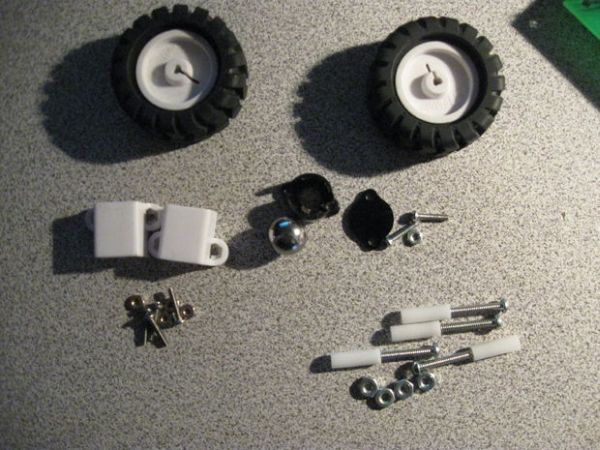I have wanted to build my own robot for awhile now. But after many tried and failed attempts, I was losing hope that may ever happen. I discovered that there wasn’t a small, robust, super easy to add-on to, robot that was within my budget to get. After hours of research and many robot kits later, i decided to build one from scratch. This includes building the base and electronics myself. I was always a fan of the Arduino and open-source electronics. The easily to obtain schematics and cheaper components made this project happen.

This instructable is more of a guide then a step by step, but still shows the steps to build a stackable robot the will last for many projects to come.
I decided on stacking sheilds (boards) (just like the REAL Arduino is like) because it is very easy to expand and change things as required. Other reasons is because the cost to build one yourself is very little compared to other kits or premade ones on the market.
This design can also be easily integrated into a Swarm of robots (I plan to do this in a future update) because of its expanansions and low costs.
Lastly, be prepared to go through plenty of revisions during planning and building of your robot.
If you have any questions about building your own, leave me a comment or message and I’ll do my best to answer them.
Step 1: Parts Required
Some of the parts required are: (links are to the items I used).
2x Proto Boards. Jameco
2x Micro Gearmotors. Pololu
2x Extended Brackets. Pololu
2x 40X19mm Wheel. Pololu
1x 3/8″ Ball Caster. Pololu
1x AAA battery holder. Digi-key
7x 0.1uf Capacitors. Modern Device
Stacking Headers. Modern Device
Double Height Headers. Modern Device (No longer available).
Male Headers. Modern Device
Female Headers. Modern Device
1x LDO 5volt Regulator. Modern Device
2x 330uf capacitors. Solarbotics
1x 47uf and 220uf capacitors. (check description below).
1x 28pin DIP Socket. Modern Device
1x 16mhz Resonator. Modern Device
1x Atmega328 with Bootloader. Modern Device
1x SN754410 Motor Driver. Digikey
1x Led.
1x Tactile Switch.
Various 1k,10k resistors. Modern Device
4x Standoffs. (got mine out of old VHS Tapes)
Various 22 guage hookup wire. (Local wire/electronic store)
Various 4-40 and 2-56 hardware. Pololu
Various Diodes. (1N4001 are recommened) Digikey
A good website to check out is Robotshop.com (International) or Robotshop.ca (Canada)
This where I actually BOUGHT the following: Gearmotors, Motor brackets, Ball caster, Wheels, Stackable headers, hookup wire, some tools and various other things to build my robots.
Some of the capacitors I used were salvaged from an old Computer CD/DVD drive (they work very well for this kinda thing because they are usually rated at 16v, usually around 220uf and are very low profile).
I recommend buying the Modern Device BBB BUB Cable Package . Because it includes the FTDI programmer, USB cable, the Bare Bones board (this board kit includes the Atmega 328, 28pin socket, Resonator, some headers, some of the capacitors, some of the resistors, right angle header, tactile switch and the LED). Cheaper then buying everything seperatly.
Step 2: Tools Required
Really just the basic tools are required like:
Soldering iron with stand
Solder
Wire Strippers
Dremel brand drill bit set.
Screwdrivers
Flush side cutters
etc.
Step 3: Planning
Using PCB Software will help with this step. I used Express PCB to help plan where some of the parts will need to go.
But no matter how much planning you have done, be prepared to make changes as you go along.
For more detail: DIY Low Cost Arduino Mobile Development Platform

